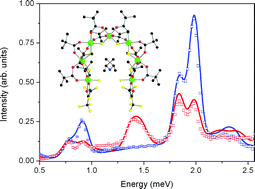Abstract of Publication No. 601
 Michael L. Baker, Alberto Bianchi, Stefano Carretta, David Collison, Rebecca J. Docherty, Eric J. L. Mclnnes,
Andrew McRobbie, Christopher A. Muryn, Hannu Mutka, Stergios Piligkos, Marzio Rancan, Paolo Santini,
Grigore A. Timco, Philip L. W. Tregenna-Piggott, Floriana Tuna, Hans U. Güdel and Richard E. P. Winpenny
Michael L. Baker, Alberto Bianchi, Stefano Carretta, David Collison, Rebecca J. Docherty, Eric J. L. Mclnnes,
Andrew McRobbie, Christopher A. Muryn, Hannu Mutka, Stergios Piligkos, Marzio Rancan, Paolo Santini,
Grigore A. Timco, Philip L. W. Tregenna-Piggott, Floriana Tuna, Hans U. Güdel and Richard E. P. Winpenny
Varying spin state composition by the choice of capping ligand in a family of molecular chains:
detailed analysis of magnetic properties of chromium(III) horseshoes
Dalton Trans. 40, 2725-2734 (2011)
![]()
![]()
Abstract:
We report a detailed physical analysis on a family of isolated,
antiferro-magnetically (AF) coupled, chromium(III)
finite chains, of general formula
(Cr(RCO2)2F)n
where the chain length n = 6 or 7. Additionally, the chains
are capped with a selection of possible terminating ligands,
including hfac (= l,l,l,5,5,5-hexafluoropentane-2,4-dionate(l-)),
acac (= pentane-2,4-dionate(l-)) or (F)3.
Measurements by inelastic neutron scattering (INS), magnetometery
and electron paramagnetic resonance (EPR) spectroscopy have been
used to study how the electronic properties are affected by
n and capping ligand type. These comparisons allowed the
subtle electronic effects the choice of capping ligand makes for
odd member spin 3/2 ground state and even membered spin 0 ground
state chains to be investigated. For this investigation full
characterisation of physical properties have been performed with
spin Hamiltonian parameterisation, including the determination
of Heisenberg exchange coupling constants and single ion axial
and rhombic anisotropy. We reveal how the quantum spin energy
levels of odd or even membered chains can be modified by the
type of capping ligand terminating the chain. Choice of capping
ligands enables Cr–Cr exchange coupling to be adjusted by
0, 4 or 24%, relative to Cr–Cr exchange coupling within the
body of the chain, by the substitution of hfac, acac or
(F)3 capping ligands to the ends of
the chain, respectively. The manipulation of quantum spin levels
via ligands which play no role in super-exchange, is of
general interest to the practise of spin Hamilton modelling,
where such second order effects are generally not considered
of relevance to magnetic properties.